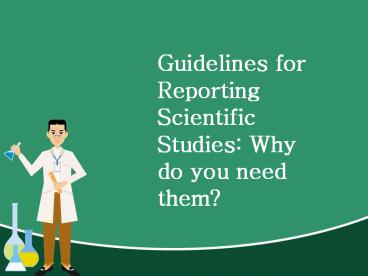Scientific Report Writing Tips - PowerPoint PPT Presentation
Title:
Scientific Report Writing Tips
Description:
Guidelines for Reporting Scientific Studies: Why do you need them? – PowerPoint PPT presentation
Number of Views:859
Title: Scientific Report Writing Tips
1
Guidelines for Reporting Scientific Studies Why
do you need them?
2
Reporting of Scientific Studies
- Accurate reporting of scientific studies is most
important. Researchers use the studies as a base
for their own research. - Clinicians use them to plan the right treatment
for the patients. - The government health agencies use them to design
impactful preventive and treatment strategies. - Thus, if you dont report the results accurately
in the scientific publications, they wont
provide any value to the society and all your
hard work will go waste.
3
So, several guidelines are introduced to ensure
the results are reported in an accurate manner.
Here, we will discuss the eleven guidelines that
are commonly used for reporting various types of
scientific studies.
4
1) PRISMA
- PRISMA (Preferred Reporting Items for Systematic
Reviews and Meta-analyses) is a guideline for
proper reporting of systematic reviews and
meta-analyses. - It is also useful for critical appraisal of a
published systematic review. - The PRISMA statement comprises a checklist of 27
items, which are divided into the categories of
title, abstract, introduction, methods, results,
discussion and funding. - It also advocates the use of a flow diagram to
present the results in an effective manner.
5
2) CONSORT
- CONSORT (Consolidated Standards of Reporting
Trials) is a statement that guides the reporting
of randomized controlled trials. - The statement was first developed in 1996 to
remove any bias in reporting the results of
randomized clinical trials. - It comprises a 25-item checklist and is divided
into categories like title and abstract,
introduction, methods, results, discussion, and
other information.
6
3) STROBE
- STROBE (Strengthening the Reporting of
Observational studies in Epidemiology) is a
guideline for reporting observational studies
like cohort, case-control, and cross-sectional
studies. - The observational studies previous to the
development of STROBE didnt explain the
confounding variables nor had any reporting on
the method of selecting the study and control
groups.
7
- To overcome this inadequacy, STROBE came into
being in 2004. - It comprises a 22-item checklist under the
headings of title and abstract, introduction,
methods, results, discussion, and other
information. - For genetic association studies, STROBE has been
extended to STREGA (Strengthening the Reporting
of Genetic Association studies).
8
4) STARD
- STARD (Standards for the Reporting of Diagnostic
accuracy studies) has been developed for accurate
reporting of diagnostic and prognostic studies. - A survey about the diagnostic studies published
in medical journals between 1978 and 1993
revealed poor or mediocre quality.
9
- They lacked a proper study design, proper method,
and difficulty in evaluating their results. - Thereafter, STARD came forth with the checklist
of 25 items under the following headlines
title/abstract/keywords, introduction, methods,
results, and discussion. - A flow diagram is recommended to report the
methods used for patient recruitment and the
order in which the tests are carried out.
10
5) SPIRIT
- SPIRIT (Standard Protocol Items Recommendations
for Interventional Trials) was created in 2007
for the reporting of scientific trial
protocols as many of them lacked information on
primary outcome, treatment allocation methods,
and the use of blinding in randomized trials. - It includes 33 items divided into the following
domains administrative information,
introduction, methods, ethics and dissemination,
and appendices. It recommends a protocol in a
specified format which includes a table of
contents, section headings, glossary, and list of
references.
11
6) CARE
- CARE (Consensus-based Clinical Case Reporting) is
developed to increase the accuracy, transparency,
and usefulness of case reports.
12
7) SRQR
- SRQR (Standards for reporting qualitative
research) is formulated to define the standards
for reporting qualitative research and preserve
the requisite flexibility to accommodate various
paradigms, approaches, and methods used in them. - Consisting of 21 items, it requires the authors
to define and explain the key elements of each
item and provide examples from recently published
articles.
13
8) SQUIRE
- SQUIRE (Standards for Quality Improvement
Reporting Excellence) guidelines provide a
framework to report any new study conducted for
improving the healthcare of the community.
14
9) CHEERS
- CHEERS (Consolidated Health Economic Evaluation
Reporting Standards) is an attempt to consolidate
and update previous health economic evaluation
guidelines into a useful reporting guidance. - It is a user-friendly 24 item checklist with
recommendations divided into following
categories title and abstract, introduction,
methods, results, discussion, and other
information.
15
10) ARRIVE
- ARRIVE (Animal Research Reporting of In Vivo
Experiments) has been laid down to report any
area of bioscience research that uses laboratory
animals, to improve the quality of information
published and reduce the number of animal studies.
16
11) AGREE Reporting Checklist
- AGREE Reporting Checklist can be used by practice
guideline developers, guideline users, funders,
peer reviewers, and journal editors to
improve the comprehension, completeness, and
transparency of reporting in practice guidelines.
17
- The purpose of having these reporting guidelines
in scientific research is to create a manual for
the authors to follow and promote total
transparency, accurate reporting, and easier
assessment of the validity of reported research
findings. - Though it has been accomplished to some degree,
but still much needs to be done. Its time
that scientific editors, authors, and journal
reviewers assemble to figure out how to best use
these reporting guidelines. - For expert scientific manuscript preparation use
our scientific writing services team to get your
research published.
18
Know More
E-mail project_at_cognibrain.com
Phone 044-49595223 URL https//www.cognibrain.
com/































